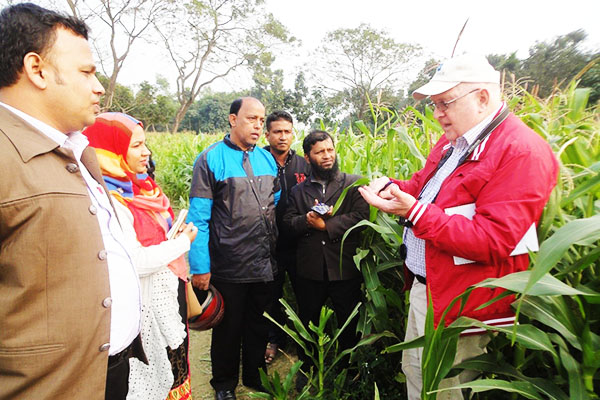
Volunteer Post
Improved Breeding Bull Management and Dairy Cattle Rearing
Archie Devore

It was my pleasure to serve as Farmer-to-Farmer volunteer in Bangladesh from January 26 to February 11, 2018. The assignment was coordinated by Winrock International with sponsorship by USAID, United States Agency for International Aid. The host recipient, BRAC Artificial Insemination (AI) Enterprise,is one part of Bangladesh Rehabilitation Assistance Committee (BRAC), the largest NGO in the world. BRAC was formed in 1972 following the liberation of Bangladesh in 1971 and now serves more than 15 countries in Asia and around the world.

I have been to Bangladesh on two prior F2F assignments with Winrock International in 2016 for Feed the Future Bangladesh and Training of Trainers to help develop improvement in dairy cattle feeding programs aiming to increase milk production and to stimulate economic development. I found the participants who were enrolled in the training programs to be eager to learn new concepts and quick to share their experiences and to inquire how to transfer new knowledge and skills with their farmer family clientele. One of the most impressive attributes of the participants was their level of education, many had attended colleges and universities and held advanced degrees. They were quick to share customs, food and family details with me.

As one would imagine, rice is a food staple in Bangladesh and is commonly eaten at all three meals.. Many fresh vegetables are available as well as fruits like mango and banana. Chicken and fish are most commonly served for lunch and dinner but mutton is also available. I never went away from a meal not feeling adequately fed and I even had to limit myself from overeating the many high calorie items! It was common to enjoy tea breaks with some snacks in mid-morning and again in mid-afternoon. The evening meal is typically eaten around 8:00 p.m., later than most westerners are used to eating.
The participants were quick to get involved in hands-on demonstrations and skills. Photos don’t do these activities justice, it is hard to convey how everyone wants to be involved and apart of the discussion when all I could capture is a group of heads, arms and backs. Never the less, the participants in this assignment were no less enthusiastic than previous assignment participants.

We spent lots of time in the bull sheds where bulls are housed and fed. Each barn had two managers, two bull handlers and one person is present in the barns at all times. Each of the employees know the bulls well. The bulls are kept clean and as comfortable as the facilities will allow. Bulls are taken to the collection center twice aweek for collection of semen. The semen is checked for quality and is processed and packed in quarter milliliter straws, which is stored in liquid nitrogen and is then distributed throughout the country where professionally trained inseminator technicians inseminate the cows. Successful conception rates of over 75% has been achieved.
I was pleased to observe the professional way the AI Enterprise is managed and its attention to detail, both important when gaining the trust of customers. Standard Operating Procedures (SOP’s) for semen collection, preservation & packing were reviewed and discussions were held. Likewise SOP’s for developing and managing the bulls was addressed along with establishment of targets for rates of daily gain and nutrient requirements to keep adequate body condition and to maintain bulls without fattening.

In the training sessions we discussed requirements for daily nutritional needs, requirements for dry matter intake and other nutrients for each 100 grams of body weight gain. I had developed a spreadsheet that allows for body weight of bull and grams body weight gain/day. This is further designed to calculate nutrients provided by each feed ingredient and calculates dry matter intake provided by the diet which is then compared to the target weight gains so that evaluations can be made to see if the ration is adequate to meet the targets. This spreadsheet does the calculations that were taught in training instantly, but is important for the participants to understand how these calculations are made and why they are important.
It was fascinating to see how quickly the participants learned and implemented the new practices into their daily schedules. Following each session they would then report what changes they had made in their daily activities. Many entries were made in Facebook and the number of “selfies” taken was too numerous to count!

Each time I complete another assignment I am enriched by having had opportunity to meet new participants who are genuinely interested in learning new skills and developing ways to improve the livelihood of the citizens in their country. Understanding the culture of people around the world and sharing each other’s dreams and aspirations creates better understanding and provides opportunity for improved chances for peace in the world. What better way to do this than to walk with others, share with others and learn from one another.
